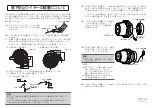
SVS-VISTEK
Feature description
40
6.3
I/O Features
6.3.1
PWM
Pulse width modulation
Description of the function used within the sequencer or implemented by
the pulseloop module
During Pulse Width Modulation, a duty cycle is modulated by a fixed
frequency square wave. This describes the ratio of ON to OFF as duty
factor or duty ratio.
Why PWM?
Many electrical components must be provided with a defined voltage.
Whether it’s because they do not work otherwise or because they have the
best performance at a certain voltage range (such as diodes or LEDs).
Diode characteristic
Since LEDs have a bounded workspace, the PWM ensures a variable
intensity of illumination at a constant voltage on the diodes.
In addition, the lifetime of a diode increases. The internal resistance is
ideal in this area. The diode gets time to cool down when operated with a
PWM in its workspace.
Implementation of PWM
The basic frequency of the modulation is defined by the cycle duration "T".
=
1
Duty cyle "T" is written into the registry by multiple of the inverse of camera
frequency. (15 ns steps) Refer to:
Time unit of the camera
.
=
1
66, 6
∙ PWMMax&SeqSelector-
= 15 ∙ PWMMax&SeqSelector-
T
H E I N T E N S I T Y O F A
P W M :
That duty ratio is calculated as:
Δ
% = t / T. It is written about the value of
"t" as PWMChange0-3[SeqSelector] per sequence into the Registry.
PWMChange0-3[SeqSelector] is to be written as a percentage value.
E
X A M P L E S O F
P W M
S
:
Summary of Contents for ECO Series
Page 5: ...SVS VISTEK Safety Messages Contents of Camera Set 5 ...
Page 94: ...SVS VISTEK Dimensions 94 ...
Page 96: ...SVS VISTEK Dimensions 96 ...
Page 97: ...SVS VISTEK Dimensions 97 ...
Page 98: ...SVS VISTEK Dimensions 98 ...
















































